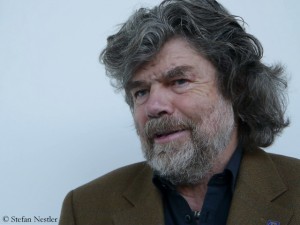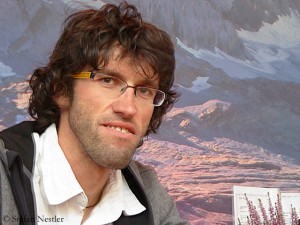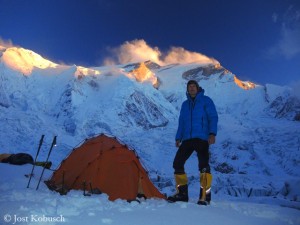Messner: “I don’t want do die in the mountains”
This man seems to be ageless. How on earth does Reinhold Messner do it? The first man who climbed all 14 eight-thousanders, responds with his motto from Tibetan: “Kalipé” – with steady feet. Ahead of his 70th birthday on Wednesday, I called him at home in South Tyrolia.
Reinhold Messner, how will you celebrate your birthday?
It will be a private birthday party, in no way a public one. There is a time and a place. I can tell you that I have invited my friends to bivouac. For the last time, at the age of 70, I will spend the night after the party outdoor, under the stars, in the sleeping bag. Most of my friends will do the same, all the others will drive to the hotel in the valley.
So, you are about to turn 70-years-old, it’s quite a milestone. How are you faring? Are you happy with life?
We don’t carry happiness around with us all the time, sometimes it just happens inside of us or around us. I have it easier these days, because I have nothing more to prove. I’m not in a rush anymore, either, but I am still active. I am very lucky that my knees still work and my joints are all okay. I have had to sacrifice a bit: like a damaged heel bone, missing toes, but otherwise, for my age, I am not going too badly. I have a lot of ideas to fill the next years, to have a worthwhile life and to be happy.
Does it happen, that you are sitting in the sun at Juval castle just day-dreaming?
Yes, sometimes, with my wife and children in the evening sun, but not as a habit. I am someone who is active, who is creating ideas and is completely absorbed in doing this. It’s perhaps one of my best models of success that I can internalize an idea so that it is growing in day and night dream, up to maturity. However, an idea in your head is only a castle in the air, but still not an adventure. But if it has turned into reality, there is something that I call a flow. Then I’m fully myself, everything is flowing. And that makes me happy.
Which goals would you like to pursue in the next decade of your life?
In the next few years I definitely want to apply myself to my mountain museum and make sure that it survives. I want that to be a lasting legacy. My farms are very important to me too. And I’d like to work as a film maker too, like an author. I want to go out with an idea, into the wild and collect pictures which then tell a strong story on the screen.
The Spaniard Carlos Soria is in the Himalayas at the moment. He wants to climb Shishapangma. It will be the 12th of the 14 mountains over 8000 meters that he has managed. The man is 75-years-old. Are you happy that you managed to do all that by your early 40s?
I am especially pleased that I managed to get it all done before anyone else was on these mountains. Back then you just had to get a permit for your expedition and your group, whether you were alone, a pair, or whether there were five of you, just worked their way up by themselves. I am lucky to have been born early enough, that I could still experience mountains in their purest form. These days 20,000 people try to climb the Matterhorn each year, and Mont Blanc is even worse. The mountains are now designed for mass tourism.
Earlier this year 500 Sherpas were preparing Mountain Everest so that thousands of clients could pay a lot of money to climb the mountain. Then there was an accident and 16 Sherpas died in an avalanche. It was like a type of industrial accident, I suppose you could say. There was a strike and the tourists went home. But next year they will come again. I hope that everyone can have the chance to climb these mountains, but what is going on here has little to do with real mountaineering. It is tourism – sure it’s hard work and it’s a bit dangerous – but the responsibility for the safety of the climb is being pushed onto the locals. This is all about showing off what you have done, and nothing to do with your experience of nature.
Do you think that last spring’s avalanche will change climbing on Everest?
So far there have been travel agencies from New Zealand, the United States, Switzerland or Germany which have been bringing their clients to the Himalayas and paying the Sherpas who prepare the route. This happens not only on Everest but on all 14 eight-thousanders. Because the clients believe that these 14 mountains have a particular prestige.
The young Sherpas have done the dirty work – the dangerous that caused the death of 16 Sherpas in the Khumbu Icefall. They say: If we lead the way and prepare the route at great risk, we also want to get the deal and don’t want to leave the profit to the Western agencies.
Do you expect that many Everest candidates will stay at home due to the events during the last spring season ?
Quite the contrary! There will be even more candidates because the Sherpas will prepare the piste in a better way again. It was clear for three or four years that such a disaster would happen sooner or later. I’m sorry to say that there is a joint guilt of the Sherpas. They prepared the route at the weakest point of the Icefall where the difficulties are at their lowest levels but the risk is greatest. That’s not really clever.
If you were giving advice to a young, adventure-seeking mountain climber these days, what would you tell him or her?
The young people have to find their own way. I wouldn’t be able to account for all that I did, when I was a 20-year-old. But I see some young climbers, who are traditional climbers achieving great things: Such as Hansjoerg Auer who climbed a 7500-meter-high peak in the Karakoram via a terribly difficult route. Or David Lama who climbed Cerro Torre free, without the bolts of Cesare Maestri. Or Alex Honnold who traversed the whole Fitz Roy group with dozens of peaks.
There are tens of thousands of peaks on the planet that haven’t been climbed. There are hundreds of thousands of different routes up the mountains that can be explored in the next years. The young climbers have learned that they don’t need to go to the famous mountains. The key, if you want to experience an adventure, is to go where the others haven’t been, so that you can decide things for yourself and you are responsible for yourself.
How high can you climb these days?
I haven’t tested it out. But in the last few years I climbed above 6000 meters a few times. I feel better up there than I do at normal altitude. I don’t know why. Perhaps in the next ten years I will regularly start going to Nepal or to the Himalayas, just for the health benefits. There was a case of a very sick man – I won’t say who it was – who had done some amazing 8000 meter climbs with his wife in his lifetime. The doctors had given up on him. He went to the Himalayas, to see his mountains for the last time and perhaps to die there. He then climbed an 8000 meter peak and he came down healthy. This medical wonder should be an incentive to researchers to not just think about the mountains as somewhere where adventurers like to play, but also as a place to potentially heal sick people.
Nowadays, I certainly wouldn’t climb Everest without bottled oxygen. At my age I don’t want to die in the mountains, after working for 65 years to do everything I can to not die there. To head up Everest with two oxygen bottles and two Sherpas, one at the front and one at the back, is not my idea of fun.










